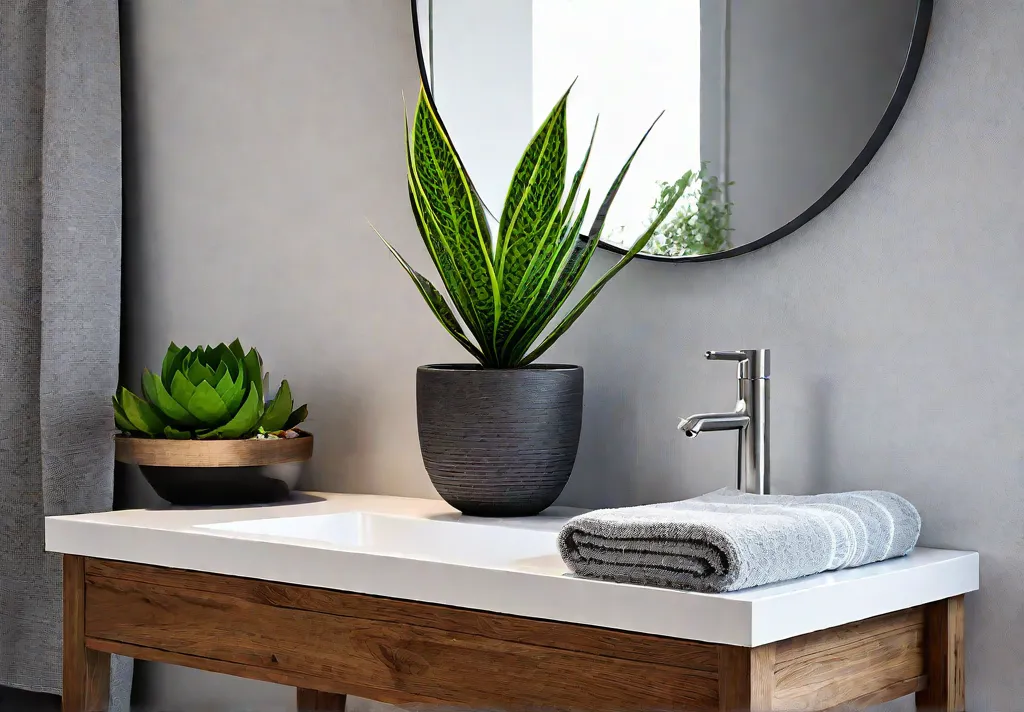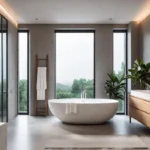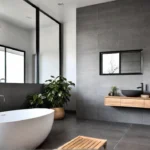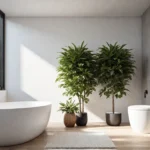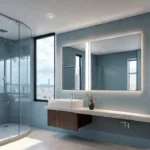In the hustle of modern life, our bathrooms often become cluttered sanctuaries, filled with expired products, towering stacks of linens, and well-intentioned decor that creates more chaos than calm. As a Venice Beach-based interior designer, I’ve witnessed countless spaces suffocating under the weight of excess. But what if I told you that true serenity lies not in accumulation, but in thoughtful curation?
Join me on a journey to transform your bathroom into a minimalist oasis. We’ll explore the art of letting go, from expired skincare to unnecessary rugs, and discover how less truly can be more. By embracing intentional design and sustainable choices, we’ll create a space that not only looks beautiful but nurtures your well-being with every visit. Are you ready to breathe new life into your daily rituals and find instant serenity in your bathroom?
Expired Products: The Silent Stressors
In our quest for bathroom serenity, we often overlook the quiet culprits lurking in our cabinets and drawers: expired products. These seemingly innocent items not only clutter our space but can also pose potential health risks. Let’s dive into the world of expiration dates and discover how to create a more mindful, minimalist bathroom environment.

The Science of Expiration Dates
Did you know that the average person keeps expired products in their bathroom for months past their expiration date? It’s a startling statistic that highlights our tendency to hoard and forget. But these dates aren’t arbitrary – they’re carefully calculated to ensure the safety and efficacy of the products we use on our bodies daily.
Expired skincare products can become breeding grounds for bacteria, potentially leading to skin irritations or infections. Sunscreens lose their protective properties, leaving your skin vulnerable to harmful UV rays. Even your trusty toothpaste can become less effective at fighting cavities and freshening breath once it’s past its prime.
Creating a Product Purge Routine
To maintain a truly minimalist and serene bathroom, we need to embrace regular product purges. Here’s a simple checklist to guide you through the process:
- Gather all products from cabinets, drawers, and countertops
- Check each item for an expiration date
- Dispose of anything that’s expired
- For products without clear dates, use these general guidelines:
- Sunscreen: 1-2 years
- Skincare products: 6 months to 1 year after opening
- Makeup: 3 months for mascara, 6-12 months for other items
- Toothpaste: 2 years from manufacture date
- Clean and reorganize your storage spaces
- Return only the items you regularly use and that spark joy
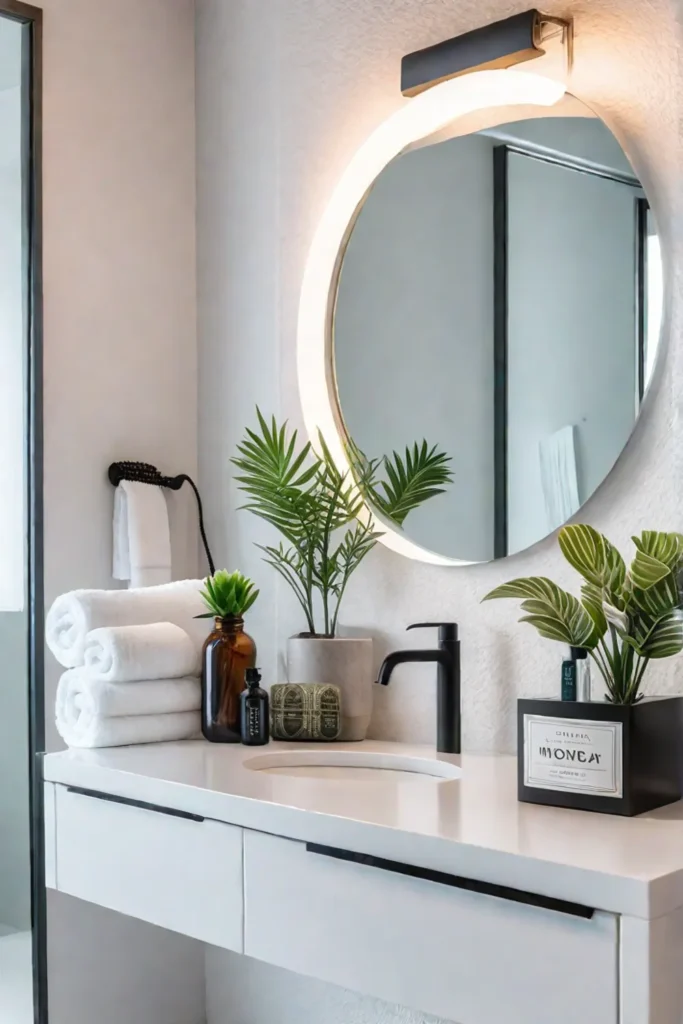
To keep this practice sustainable, set calendar reminders for a quarterly product purge. This simple act of mindfulness will not only declutter your space but also ensure you’re using safe, effective products.
Remember, a minimalist bathroom isn’t about deprivation – it’s about intentionality. By regularly assessing and curating the products we keep, we create space for what truly matters and contribute to a more sustainable lifestyle.
As we continue our journey towards bathroom serenity, let’s turn our attention to another common clutter culprit. In the next section, we’ll explore the art of “Taming the Towel Tower: Finding Your Minimalist Number” and discover how to strike the perfect balance between comfort and simplicity in our linen choices.
Taming the Towel Tower: Finding Your Minimalist Number
In our quest for bathroom serenity, we often overlook one of the biggest culprits of visual clutter: the towering stack of towels. As a Venice Beach-based interior designer, I’ve seen countless bathrooms overwhelmed by an unnecessary abundance of terrycloth. Let’s dive into how we can streamline our towel collection for a more zen bathroom experience.
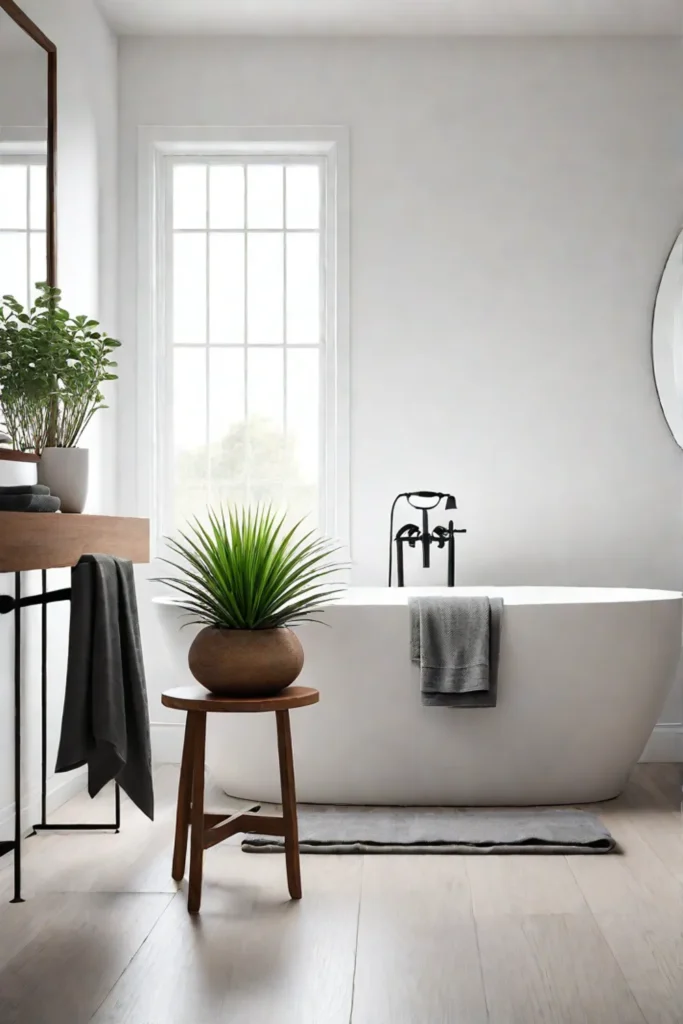
The Towel Tally: How Many Do You Need?
The average American household often has far more towels than necessary, contributing to both visual and physical clutter. But how many towels do we need? The answer lies in understanding your household’s unique rhythms and routines.
Here’s a simple guide to help you determine your ideal towel count:
- Calculate one bath towel per person, plus one extra
- Add one hand towel per bathroom
- Include two washcloths per person
For a family of four, this translates to:
- 5 bath towels
- 2-3 hand towels (depending on the number of bathrooms)
- 8 washcloths
This minimalist approach ensures you have clean towels available while reducing unnecessary excess. Remember, the goal is to create a sense of spaciousness and calm in your bathroom sanctuary.
Sustainable Storage Solutions
Once you’ve curated your towel collection, it’s time to consider storage. The key is to keep your towels accessible yet visually unobtrusive. Here are some of my favorite eco-friendly storage ideas:
- Wall-mounted wooden ladder: A reclaimed wood ladder adds warmth while providing vertical storage.
- Woven baskets: Natural fiber baskets offer a touch of texture and can be easily tucked away.
- Floating shelves: Sleek wooden shelves provide open storage without overwhelming the space.
- Behind-the-door hooks: Utilize often-forgotten door space with simple, organic wooden hooks.

The Art of Towel Maintenance
To keep your minimalist towel collection fresh and functional, establish a regular washing routine. Generally, bath towels should be washed every 3-4 uses, while hand towels need more frequent washing due to higher use.
Pro tip: Invest in high-quality, organic cotton or linen towels. They’ll not only last longer but will also bring a touch of luxury to your daily routine while aligning with a sustainable lifestyle.
By thoughtfully curating your towel collection and storage, you’re creating more than just a clutter-free space. You’re crafting a bathroom that serves as a restorative sanctuary, where every element has purpose and beauty.
As we continue our journey toward bathroom serenity, let’s turn our attention to another common source of visual noise. In the next section, we’ll explore how to tackle decorative clutter and transform your bathroom into a truly tranquil oasis.
Decorative Clutter: Curating a Tranquil Oasis
We often overlook the impact of decorative elements. While the intention behind these items is to beautify our space, they can inadvertently create visual noise that disrupts our sense of calm. Let’s explore how to strike the perfect balance between aesthetics and tranquility.

Identifying Unnecessary Decor
Take a moment to scan your bathroom. Do you see a collection of mismatched trinkets, an overflow of products on display, or an abundance of wall art? These seemingly innocent additions can contribute to a chaotic atmosphere. Studies have shown that cluttered environments increase stress levels, which is counterproductive to the restorative nature we seek in our bathrooms.
Common culprits of bathroom clutter include:
- Multiple small picture frames
- Decorative soap dispensers and toothbrush holders
- Excessive candles or diffusers
- Outdated magazines or books
- Novelty signs or plaques
Choosing Calming and Functional Pieces
The essence of minimalist design lies in the mantra “less is more.” By curating a few meaningful items, we can enhance the aesthetic of our space while maintaining its serenity. When selecting decor for your bathroom, consider pieces that serve a dual purpose of beauty and function.
Here are some minimalist-friendly alternatives to consider:
- A single, striking piece of wall art that resonates with you
- A sleek, wall-mounted soap dispenser in a natural material like wood or stone
- One or two potted plants to bring life and purify the air (try low-maintenance options like snake plants or pothos)
- A natural sea sponge or wooden bath brush for texture and utility
- A handcrafted ceramic tray to corral essential items

Remember, the goal is to create a space that feels open, airy, and intentional. Each item should earn its place by contributing to the overall sense of calm and well-being.
The Power of Negative Space
In minimalist design, negative space – the areas left empty – is just as important as the objects we choose to include. These open areas allow the eye to rest and the mind to decompress. Don’t feel pressured to fill every surface or wall; instead, embrace the tranquility that comes with thoughtful restraint.
By paring down our decorative elements, we’re not just decluttering – we’re creating room for mindfulness and presence. A simplified space allows us to focus on the sensory experiences of our self-care routines, from the warmth of the water to the scent of our favorite soap.
As we continue our journey towards a more serene bathroom, let’s turn our attention to an often overlooked element that can make a significant impact on both aesthetics and comfort. In the next section, we’ll explore “Rethinking the Bathroom Rug: A Minimalist Perspective,” and discover how this simple item can transform the look and feel of our space.
Rethinking the Bathroom Rug: A Minimalist Perspective
The humble bathroom rug, a staple in many homes, might be due for a minimalist makeover. As we continue our journey towards a serene bathroom sanctuary, it’s time to cast a critical eye on this often-overlooked element. Let’s explore why rethinking our approach to bathroom floor coverings can lead to both a cleaner space and a clearer mind.

The Hygiene Factor: Pros and Cons of Bathroom Rugs
Traditional bathroom rugs, while cozy underfoot, can be a breeding ground for unwanted microorganisms. In fact, studies have shown that bathroom rugs can harbor up to 2000 times more bacteria than a toilet seat. This sobering statistic alone might be enough to make us reconsider their place in our minimalist havens.
Pros of bathroom rugs:
- Provide warmth and comfort for bare feet
- Absorb water, reducing slip hazards
- Add a decorative element to the bathroom
Cons of bathroom rugs:
- Trap moisture, leading to mold and mildew growth
- Collect dust, hair, and other debris
- Require frequent washing and maintenance
For those who choose to keep their bathroom rugs, regular cleaning is essential. Aim to wash them at least once a week in hot water with a natural, eco-friendly detergent. Hang them to dry completely before placing them back on the floor to prevent moisture buildup.

Exploring Minimalist-Friendly Alternatives
As we embrace a more minimalist approach, it’s worth considering alternatives that align with both our aesthetic and practical needs. The goal is to create a space that feels open, clean, and intentional.
- Textured Floor Tiles: Opt for non-slip, textured tiles that provide grip without the need for additional coverings. Natural stone or porcelain tiles with a slight texture can offer both safety and style.
- Wooden Bath Mats: A teak or bamboo bath mat brings a touch of nature indoors while offering excellent water resistance and quick-drying properties.
- Cork Flooring: This sustainable material is naturally antimicrobial and provides a warm, soft surface underfoot.
- Micro-Fiber Bath Mats: If you prefer a fabric option, choose a quick-drying microfiber mat that can be easily washed and dried.
- Bare Floors: For the ultimate minimalist approach, consider embracing your bare floors. A squeegee can quickly remove excess water after showers, maintaining a clean and open feel.
By rethinking the bathroom rug, we open ourselves to a world of possibilities that honor both form and function. These alternatives not only contribute to a cleaner, more hygienic space but also align with the principles of biophilic design, bringing us closer to nature and promoting a sense of well-being.

As we simplify our bathroom floor coverings, we create space for serenity and ease. This mindful approach to our environment extends beyond aesthetics, influencing our daily rituals and overall sense of calm. Remember, in the pursuit of minimalism, every element should serve a purpose and bring joy to our lives.
Now that we’ve addressed the floor, let’s turn our attention upward and inward. In our next section, “Conquering Cabinet Chaos: Organization for Inner Peace,” we’ll explore how to bring order to one of the bathroom’s most cluttered areas, creating a harmonious space that reflects our commitment to mindful living.
Conquering Cabinet Chaos: Organization for Inner Peace
In our journey towards bathroom serenity, we’ve tackled visual clutter and unnecessary items. Now, let’s dive into the heart of bathroom organization: the cabinets. These hidden spaces often become catch-alls for products we rarely use, creating a chaotic energy that seeps into our daily routines.

Decluttering and Categorizing Bathroom Essentials
The first step in cabinet transformation is a thorough edit. Empty everything onto a clean surface and group similar items together. This process often reveals just how much we’ve been holding onto unnecessarily. As you sort, ask yourself:
- When was the last time I used this?
- Does this item truly serve me or my space?
- Is this product still effective, or has it expired?
Be ruthless in your decluttering. Remember, every item you keep requires energy to maintain and organize. By streamlining your essentials, you’re not just clearing physical space – you’re creating mental space for clarity and calm.
Maximizing Space with Smart Storage Solutions
Once you’ve curated your bathroom essentials, it’s time to reimagine your storage. The goal is to create a system that’s both beautiful and functional, where every item has a designated home.

Consider these innovative solutions:
- Tiered shelves: Utilize vertical space to maximize storage and visibility.
- Lazy Susans: Perfect for corner cabinets, these rotating trays make items easily accessible.
- Clear containers: Group similar items in transparent bins for a clean, cohesive look.
- Drawer dividers: Custom-fit organizers keep smaller items neatly arranged.
By implementing these strategies, you’ll transform your cabinets into serene, organized spaces that support your minimalist bathroom vision.
The Ripple Effect of Organization
An organized bathroom cabinet does more than just look good – it fundamentally shifts how we interact with our space. When everything has a place, we spend less time searching and more time being present. In fact, studies suggest that the average person spends over 150 hours per year looking for misplaced items. By reclaiming this time, we open ourselves up to moments of mindfulness and self-care.
Moreover, an organized space promotes intentional consumption. When we can clearly see what we have, we’re less likely to buy duplicates or unnecessary products. This not only saves money but also aligns with a more sustainable, minimalist lifestyle.

Remember, the goal isn’t perfection – it’s creating a space that supports your well-being. As you organize, focus on solutions that feel intuitive and easy to maintain. The most beautiful systems are those that seamlessly integrate into your daily life, requiring little effort to upkeep.
As we conclude our minimalist bathroom journey, let’s reflect on how these small changes can create a ripple effect of calm throughout our homes and lives. In our final section, we’ll explore how to sustain this newfound serenity and integrate these principles into our broader living spaces.
Wrapping Up
As we conclude our minimalist bathroom journey, take a moment to envision the serene space you’ve created. By letting go of expired products, taming the towel tower, curating decor with intention, rethinking floor coverings, and conquering cabinet chaos, you’ve not only decluttered your physical space but also cleared mental pathways for peace and presence.
Remember, this transformation is more than just aesthetic – it’s a commitment to mindful living that ripples through every aspect of your life. Each time you step into your newly serene bathroom, let it serve as a reminder of the power of intentional choices and the beauty of simplicity. As you continue to refine and evolve your space, may it always remain a sanctuary of calm in life’s beautiful chaos. Here’s to fewer things and greater joy – the essence of true bathroom bliss.
